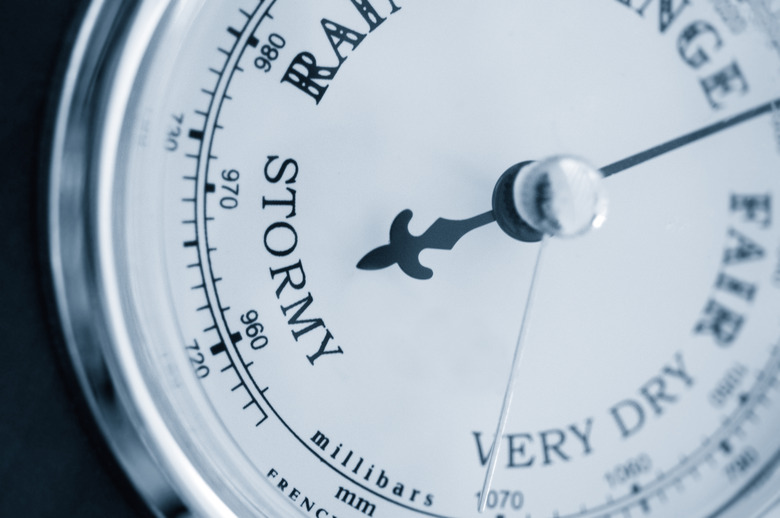How A Humidity Gauge Works
What a Humidity Gauge Measures
What a Humidity Gauge Measures
Humidity, a measure of water vapor in the air, is one of the variables measured in basic meteorology. There are actually several different kinds of humidity, but what most people mean when they talk about "humidity" is relative humidity. Relative humidity is defined by Perry's Chemical Engineers' Handbook as "the ratio of the partial pressure of water vapor in the mixture to the saturated vapor pressure of water at a prescribed temperature."
In other words, relative humidity is an indirect way of measuring of how much water vapor is in the air at a given time, versus how much water vapor the air can hold at maximum. It is expressed as a percentage. When the relative humidity gets to 100 percent, water vapor in the air begins to condense back into liquid water: It will rain.
Relative humidity is useful to know because it gives an idea of how "wet" the air feels. Low relative humidity can lead to dry skin, itchiness, and thirstiness. High relative humidity makes cold temperatures feel colder and hot temperatures hotter. When the weather is very hot, high humidity impairs the body's ability to cool down by sweating. Relative humidity also has an impact on delicate machinery such as computer circuit boards and on the development of microorganisms and fungi. Inside the home, high humidity makes mildew more likely to develop, while low humidity facilitates the spread of the flu virus.
For all of these reasons, and more, it is useful to be aware of the relative humidity. Collectively, any of the instruments used to measure humidity is referred to as a hygrometer, a humidity gauge.
Cooled Mirror Dew Point Hygrometer
Cooled Mirror Dew Point Hygrometer
One of the most precise and modern types of hygrometer is called a "cooled mirror dew point hygrometer." A mirror is chilled, which causes condensation to form on its surface. The higher the relative humidity, the more condensation forms. This is measured using an optical sensor that detects the droplets distorting the smooth surface of the mirror. These hygrometers are electronic devices that require special expertise to build.
Leonardo's Hygrometer
Leonardo's Hygrometer
The first known hygrometer was invented about 500 years ago by Leonardo da Vinci. He came up with the idea of weighing a ball of wool, whose weight would change depending on the moisture in the air. This was not a very effective design, and it would be a long time before relative humidity could be measured accurately.
Hair Hygrometer
Hair Hygrometer
A little over 200 years ago, a scientist named Horace Bénédict de Saussure invented a hygrometer involving a strand of hair, from humans or animals. Depending on the relative humidity, the hair would shrink or grow in length by a very small amount, growing longer in high humidity and shrinking in low humidity. When the hair is placed under tension, this change can be measured. These so called "hair hygrometers" are still used today.
Psychrometer
Psychrometer
The most well-known type of hygrometer is called a "psychrometer." (Psychrometry is a field of engineering concerned with the properties of mixtures of gas and vapor. "Psychro" is a Greek root that means "cold.") A psychrometer works by using two thermometers in tandem. One of the thermometers is continuously kept wet by being covered with something like a wet cloth. As the water evaporates from the cloth, it absorbs energy, lowering the temperature in the immediate vicinity. (It's the same reason that your swimsuit feels cold after you get out of a swimming pool or hot tub.) This temperature drop is measured by the wet thermometer, which records a lower temperature than it otherwise would.
The other thermometer stays dry and is used as a reference. It measures the actual temperature of the air. The relative humidity can then be calculated by measuring the difference in temperature readings between these two thermometers. If the temperature difference is low, then the relative humidity must be high, because it means less water is able to evaporate from the cloth covering the wet thermometer, which in turn means that the air already has a lot of water in it. Likewise, if the temperature difference is high, then the relative humidity must be low, since more water is able to evaporate from the cloth.
Psychrometers are only effective if they are very precisely calibrated, and they must be recalibrated frequently.
References
- "Teacher's Weather Sourcebook"; Tom Konvicka; 1999
- "Water Vapor Measurement"; Pieter R. Wiederhold; 1997
- "Perry's Chemical Engineers' Handbook (7th Edition)"; R.H. Perry and D.W. Green; 2007
Cite This Article
MLA
Fredman, Josh. "How A Humidity Gauge Works" sciencing.com, https://www.sciencing.com/humidity-gauge-works-5645763/. 14 November 2009.
APA
Fredman, Josh. (2009, November 14). How A Humidity Gauge Works. sciencing.com. Retrieved from https://www.sciencing.com/humidity-gauge-works-5645763/
Chicago
Fredman, Josh. How A Humidity Gauge Works last modified March 24, 2022. https://www.sciencing.com/humidity-gauge-works-5645763/
